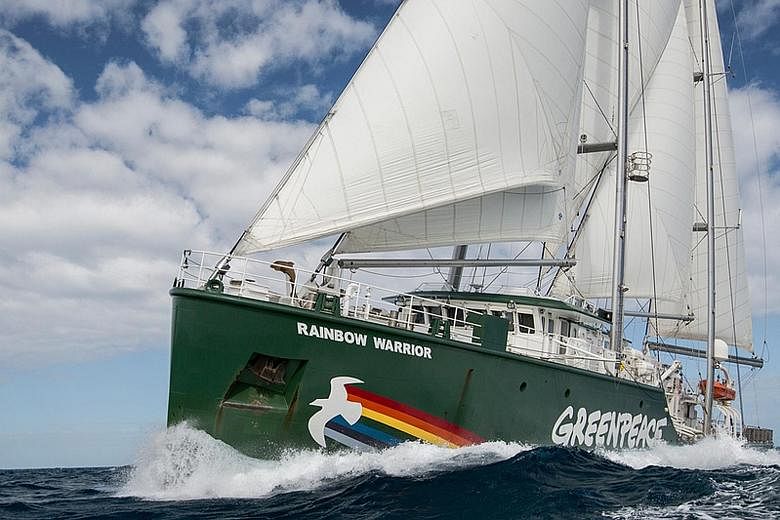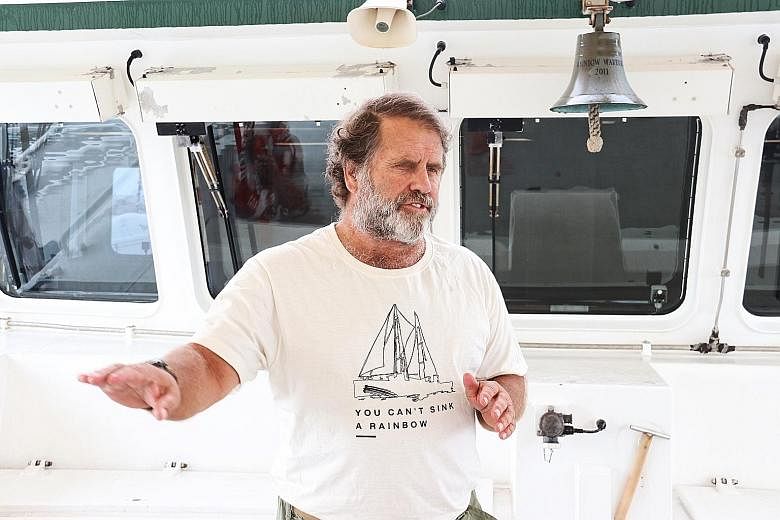A ship with a famous name returned to Singapore on Monday to continue its global mission for action against climate change.
The Rainbow Warrior, first launched by environmental organisation Greenpeace 40 years ago, made its first official visit to Singapore, having previously visited only to rest its crew and stock up on supplies.
The third version of the Rainbow Warrior was docked here for three days as part of Greenpeace's five-month climate action tour of South-east Asia.
More than 100 Singaporeans from environmental groups and civil service sectors were invited to view a climate change exhibition and attend a campaign talk aboard the ship on Tuesday.
"Greenpeace is grateful for the opportunity to be here in Singapore with the Rainbow Warrior," said its captain, Mr Peter Willcox.
"She is a very special ship... (she) stands in solidarity with the people who are fighting to reclaim their rights to a healthy and peaceful environment."
Greenpeace was founded in 1971 in Vancouver, Canada, with a message of a green and peaceful future, which it chose to spread by ship.
Its first flagship - also called Rainbow Warrior - held its first voyage on April 29, 1978, to Iceland, to oppose the commercial whaling programme there.
But its exploits have not always been welcome.
On July 10, 1985, the first Rainbow Warrior was bombed by the French secret service in an attempt to counter the ship's protest against French nuclear testing in Mururoa Atoll.
Mr Willcox started sailing with Greenpeace in 1981, and was appointed captain the same year. He witnessed the 1985 bombing, which resulted in the death of photographer Fernando Pereira.
Mr Willcox said he would not trade his job for anything else in the world. "I have three children. I want to leave them some kind of planet that's fit to live on, and right now, we're not doing it. We're failing miserably," he said.
"My motivation is that I'm concerned. I don't want to leave a big mess for my children to clean up."
The 16-strong crew aboard the Rainbow Warrior come from 10 different countries, including Lebanon and Indonesia.
The Rainbow Warrior's South-east Asian voyage began in the Philippines in February. It has since visited Indonesia and southern Thailand, before arriving in Singapore.
It travelled from Singapore yesterday to Malaysia, and will round up the trip in Phuket.
Built from scratch and designed specifically for Greenpeace's environmental missions, the Rainbow Warrior is one of the most energy-efficient ships in operation today.
It sails primarily using wind power, rather than fuel, due to its 55m-high, A-Frame mast system, which carries far more sail than a conventional mast of the same size.
On average, the Rainbow Warrior burns half a tonne of fuel a day, as compared with a typical ship of the same size which burns close to four tonnes.
Greenpeace South-east Asia executive director Naderev "Yeb" Sano said: "It is fitting that the Rainbow Warrior is here in Singapore as the Government has marked 2018 to be the Year of Climate Action.
"We hope to work closely with the Singapore Government and civil society in the future, and look forward to what the country can deliver under the Paris Agreement."


